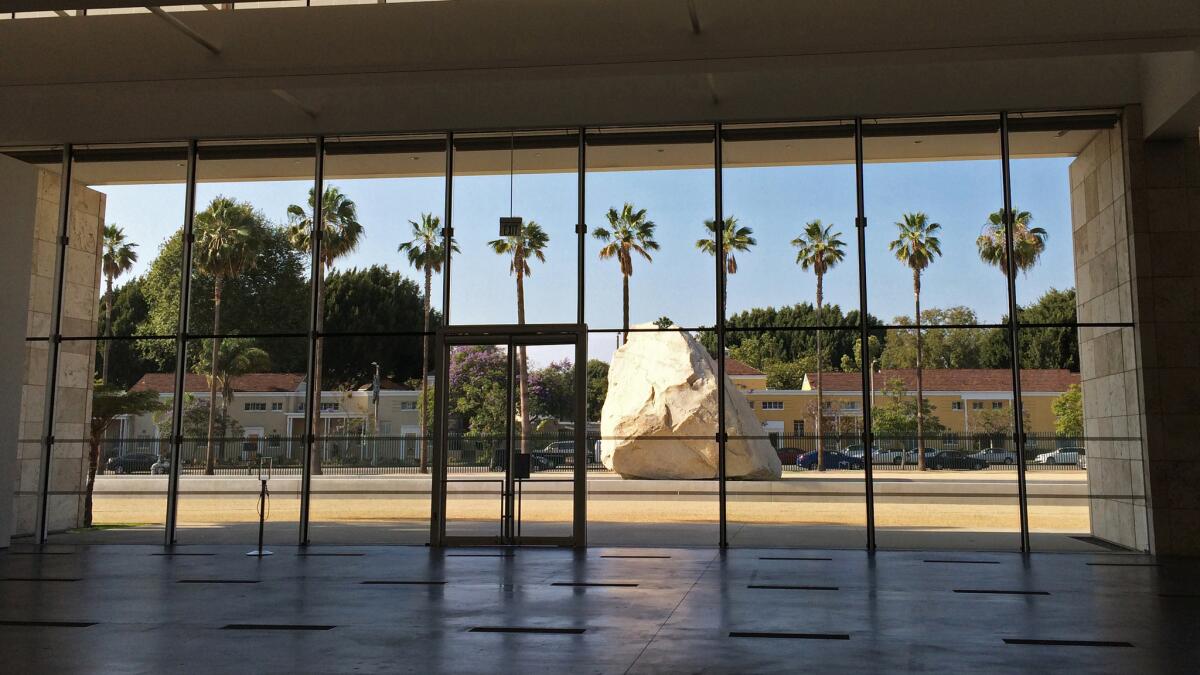How to look at Michael Heizer’s giant rock at LACMA: the inside view

For three years, Michael Heizer’s megalith sculpture “Levitated Mass” has sat in a specially designed courtyard at
When Michael Heizer’s 340-ton boulder was planted at the Los Angeles County Museum of Art after a triumphal 11-day, 105-mile journey, it was greeted with curiosity and ebullience on the day of its public opening, June 24, 2012. But in some corners, there was a tinge of disappointment.
Surrounded by the empty acreage at Fairfax and 6th Street, “Levitated Mass” seemed smaller than its media-saturated move would have implied. And there was the somewhat anti-climactic experience of walking beneath the sculpture, partly due its engineering: a pair of large steel plates to hold the rock in place over its concrete canal.
These plates, required for seismic purposes, were the subject of much derision on social media for their lack of aesthetic appeal.
“Any illusion of levitation was erased,” Victoria Dailey, in the L.A. Review of Books, wrote of the plates. “The novelty of walking under a securely fastened rock hardly registered on the shock and awe scale.”
In a nuanced review about the sculpture’s strengths and weaknesses, Los Angeles Times critic Christopher Knight, described the piece as “a good sculpture if not a great one.”
“‘Levitated Mass’ isn’t exactly Stonehenge or Half Dome,” he wrote. “It’s not even Eagle Rock. As monoliths go, the stone seems rather modest.”
When the piece opened, I felt a general appreciation toward the sculpture’s intent: this behemoth piece of nature plopped into the epicenter of concrete-covered L.A. That said, I’ve always felt underwhelmed by the walk underneath the piece. The concrete trench feels too tall and too wide — sapping the boulder of some of its power and scale. And those omnipresent steel plates are the first thing you see when you stand underneath the rock.
Over repeated visits to LACMA, I still remain underwhelmed by the walk underneath “Levitated Mass.” But there are other aspects of the piece that have grown on me — and for which I have developed a deep and abiding respect.
My favorite view of the rock isn’t from underneath or even from outside: it’s from inside the neighboring Resnick Pavilion, where the museum holds its temporary exhibitions.
Over the last three years, I’ve made repeated visits to the Resnick — to see paintings from the age of Caravaggio or Swiss architect Peter Zumthor’s schematics for a new LACMA. Inside the space, I’ll absent-mindedly round a corner and be confronted by the sight of Heizer’s boulder overwhelming a window or a door.
Each time, I’m impressed by its power and weightiness — by its sheer neolithic presence. Often, it can make objects in the galleries seem almost trivial. What’s a 400-year-old painting when you’re staring at geological time?
Last week, I saw the boulder on my trip to visit Chris Burden’s “Ode to Santos Dumont.” For 15 minutes, I watched Burden’s white zeppelin putt-putt in circles around the room. Then I spent an even longer time admiring Heizer’s boulder. It appeared to lean joyfully into the rays of the falling sun, neatly framed by Robert Irwin’s palm trees. It was majestic and beautiful (so much so, that I snapped the photo at the top of this post).
It also offered an interesting lesson about the place of humans on this planet: We can make our paintings and build our toys but what really matters is standing right outside. Nature, it turns out, is often the best artist of all.
“Levitated Mass” is on view at the Los Angeles County Museum of Art through forever, 5905 Wilshire Blvd., Los Angeles, lacma.org.
Find me on the Twitters @cmonstah.
More to Read
The biggest entertainment stories
Get our big stories about Hollywood, film, television, music, arts, culture and more right in your inbox as soon as they publish.
You may occasionally receive promotional content from the Los Angeles Times.







